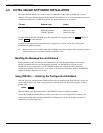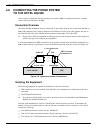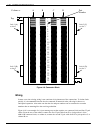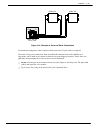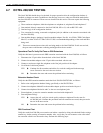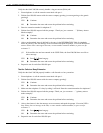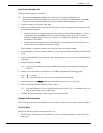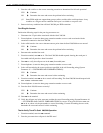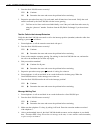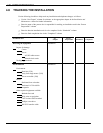
Installation 4−31
PB60019−01 Octel 200/300 S.4.1
1. Connect telephone B to the modular-adapter position associated with port 1 of the Octel 200/300.
2. From telephone A, call the extension number associated with telephone B.
3. Answer telephone B, and perform a hookswitch flash or press the transfer key if available.
4. Does the PBX provide a stutter or solid dial tone after the hookswitch flash?
YES
' If either tone is present, continue to step 5
NO
' Stop and correct the problem before continuing.
5. Enter the transfer initiate code, if any, then enter the extension number associated with telephone C.
6. After several ringbacks, perform a hookswitch flash or other key press, if required, to reconnect to
telephone A.
7. Did telephone C stop ringing? Were you reconnected to telephone A, which was on hold?
YES
' Connect telephone B to the next Octel 200/300 port extension and
continue until the extensions for each port are tested.
NO
' Determine the cause and correct the problem before continuing.
8. Make telephone C busy by taking it off-hook. Then repeat the test, starting with step 1 and calling a
busy extension instead of the ring-no-answer extension.
. The extension number connected to telephone C should start with the same first digit as those
configured in the USER Table.
Test for Calls to the Intercept Extension (Attendant)
Verify that each extension can transfer a call to the intercept extension (attendant), as follows:
1. Connect telephone B to the modular-adapter position associated with port 1 of the Octel 200/300.
2. From telephone A, call the extension number associated with telephone B.
3. Answer telephone B, and perform a hookswitch flash or press the transfer key, if available. Press
0
(or the attendant’s extension number), then hang up telephone B.
4. Did telephone A connect with the operator?
YES
' Continue test for all extensions, then proceed to the test in the next section.
NO
' Determine the cause and correct the problem before continuing.
. Some PBXs do not allow a blind (unscreened) transfer to an attendant. If this is the case, do
not assign Attribute 15 — TRANSFER TO A RINGING EXTENSION, to the COS for this
mailbox.
When all Octel 200/300 port extensions pass these tests, proceed by connecting the 25-pair cables to
the Octel 200/300 and test the message server for standard operation. The Octel 200/300 must
initialize each of the PBX ports. To verify that all the ports are initialized, at the @ prompt, enter
PS.
All ports should return IDL.
Test for Call to a Ring-No-Answer Extension
. The extension to be called must have a valid first digit (a mailbox with this first digit must already
exist in the USER Table) or be entered in the USER Table as a mailbox (mailbox number same as
the extension number and a COS).




